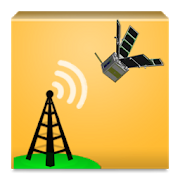AndroideSimple Apps
ISS?
The ISS (International Space Station),completing one orbit around the earth every 92 minutes,approximately.This application places the ISS on the map in real time.Calculate the orbit from the current time of device and TLE data,which obtained www.celestrak.com.Green line is drawn 50 minutes before and after the currentposition of the ISS.The user's position is marked with an android with the arm heldhigh, surrounded by a semi-transparent red circle.The red circle indicates approximately the area where the ISS wouldbe visible by the user. That is, if the ISS is inside the circle,in theory, you could watch it at the sky. Remember, NEVER LOOKDIRECTLY AT THE SUN!Internet access is used to obtain maps and update once a day TLEdata. More zoom means more data traffic.From the preferences menu you can enable/disable automatic trackingon the map.The local time Can also be superimposed on the map.Visible Passes.Although you can get to see the ISS for the day is much easier tosee at night, because in the night sky is the second brightestobject after the Moon and before of Venus.But to be visible at night must be some circumstances:-The ISS must be illuminated by the sun, ie outside the cone ofshadow of the Earth.-The sun must be at least 10 degrees below the horizon or, in otherwords, must have had at least 40 minutes before or must miss morethan 40 minutes to come out.-In its pass, the ISS must rise more than 5 degrees above thehorizon. Less than 5 degrees is not visible by the distortiongenerated by the atmosphere.From the main application window, pressing the menu key you canselect "Visible Pass".From this screen we have the date, time and position of theobserver and a refresh button (circular arrow).Pressing the button proceed to calculate the visible pass for thenext 2 days (changeable in preferences screen).The result is a list of steps visible. Each step consists of:-Day and month.-Initial instant. Time, altitude in degrees, azimuth in degrees(cardinal point equivalent)-Instant of Maximum altitude. Time, altitude in degrees, azimuth indegrees (cardinal point equivalent)-Final instant. Time, altitude in degrees, azimuth in degrees(cardinal point equivalent)Alarms: You can on/off pressing alarm button (top-left icon).3D Locator.The locator uses accelerometer, the compass of the device and thecalculated data to show the position of the ISS on sky fromobserver's position.That is, when we moves the device to the sky shows a red trianglein the position of the ISS and a green dotted line showing thevisible pass.It also includes a positioning aid, based vibration:- Hold the device pointing to the horizon, turn on your feet so asto vary only the azimuth (N, NE, E, SE, S, SW, W, NW). When theazimuth differs from the ISS in less than 10 ° there is avibration.- Now vary the altitude, vibration intensifies as it approaches theISS and will be greatest when the red triangle is displayed.- You can activate / deactivate the vibration by touching thescreen.Notes:Altitude: The angle of a celestial object measured upward from thehorizon of the observer. An object on the horizon has altitude 0 °while one directly overhead the observer is 90 °.Azimuth: The direction of celestial object measured along thedirection of clockwise from the northern horizon of the observer.An object in the north has azimuth 0 °, east 90 °, south 180 ° and270 ° westExtensions:If you like the app you can donate to developer from Extensionsmenu.Thanks.
Iridium
The Iridium communication satellites have apeculiar shape with three polished door-sized antennas, 120° apartand at 40° angles with the main bus.Occasionally, an antenna reflects sunlight directly down at Earth,creating a predictable and quickly moving illuminated spot on thesurface below of about 10 km diameter. To an observer this lookslike a bright flash, or flare in the sky, with a duration of a fewseconds.This app displays in real-time where is each Iridium satellite,predicts when these flares will occur from the observer's positionand allows from the 3D locator, locate the exact point in the nightsky.Gets the data needed from android device (accelerometer, compass,location) and from the following urls:www.celestrak.com and www.heavens-above.com
Tiangong 1?
Tiangong 1 is a Chinese space station underconstruction that is in orbit since September 29, 2011.This application places Tiangong 1 on the map in real time, andother 146 satellites, including the ISS. (I recommend installbefore "ISS?" , is more easy).Calculate the orbit from the current time of device and TLEdata, which obtained www.celestrak.com.Red line is drawn 50 minutes before and after the currentposition of the satellite.The user's position is marked with an android with the arm heldhigh, surrounded by a semi-transparent red circle.The red circle shows approximately the area in which thesatellite would be visible by the user.Internet access is used to obtain maps and update once a day TLEdata. More zoom means more data traffic.From the main application window, pressing the menu key, you canselect other satellites.Visible pass:At night you can see many satellites, some are very bright asthe ISS and others require a more darker sky.From the main application window, pressing the menu key, you canselect "Visible Pass".From this screen we have the date, time, position of theobserver and two buttons.Pressing the left button (arrow circular with dot in the center)are calculated the visible passes for all satellites for tonight,sorted by time of onset.Pressing the right button (circular arrow) the visible passesare calculated for the next two days for satellite selected on themain screen.Clicking on one of the visible passes entered the 3Dlocator.3D Locator.The locator uses accelerometer, the compass of the device andthe calculated data to show the position of the satellite on skyfrom observer's position.That is, when we moves the device to the sky shows a redtriangle in the position of the satellite and a red dotted lineshowing the visible pass.
TelegramSpeak 1.0
TelegramSpeak is a complementtoTelegram.Translate to voice messages received.Once configured not need to touch anything to hearthemessages.You can, for example cycling while listening (at your own risk).Before using TelegramSpeak need:-Have Telegram installed.-Have installed a speech synthesizer (TTS). Most devices haveitby default, if not is your case I put a link below todownloadit.-Once installed TelegramSpeak must authorize the service. TurnOnTelegramSpeak service in the accessibility window. This windowisdisplayed the first time you use TelegramSpeak.Now you can start, there are three modes:-Silence: You use Telegram as usual, without speaking.-Contact only: Discreet Mode, just says contact, and groupifapplicable.-Contact and message: It tells you the name, group ifapplicable,and the message content.To function properly you must turn off the screen ofthedevice.Finally, if you like the app you can give 5 stars, je je.... Even can make a donation from the Extensions Menu.To download a TTS:https://play.google.com/store/apps/details?id=com.svox.langpack.installer
OSCAR 1.6
OSCAR: Orbiting Satellite Carrying Amateur Radio. Somesatellitescarry radio repeaters that can be used by amateur radiofrom theground. This application helps the amateur to know the realtimeposition of these satellites. It shows on the map the positionofthe satellite, semi circle representing the approximate coverageaswell as the user's position. You can switch from the menutheselected satellite. From the menu visible passes shown awindowwith two buttons on the top. Pressing the right (circulararrow)visible passes are calculated for the selected satellitewithin 24hours. Pressing the left (arrow circular dot in thecenter) visiblepasses are calculated for all satellites for thenext 3 hours.Clicking on one of the visible passes entered the 3Dlocator. 3DLocator. The locator uses accelerometer, the compass ofthe deviceand the calculated data to show the position of thesatellite onsky from observer's position. That is, when we movesthe device tothe sky shows a red triangle in the position of thesatellite and adotted line showing the pass. The app calculates theorbits fromthe current time of the device and TLE data thatwww.celestrak.comobtained. The internet is used to get the maps andupdate TLE data.If you like the app you can make a donation to thedeveloper fromthe menu extensions. v1.2 Option to manually includethe TLE datain a file on the SDCard with satellites that the userwants isadded. /sdcard/com.androidesimple.oscar/TLE.txt For eachsatelliteinclude 3 lines like these. IRIDIUM 8 1 24792U97020A13350.44946552 .00000550 00000-0 18933-3 0 6234 2 2479286.3985133.2143 0002 005 108.3180 251.8234 14.34218916869917 Fromthepreferences menu of the main screen mark the check "TLE datafromfile in SD" For now, this option is only available to donorsusers.v1.4 Fixed bug. The first time you do not get frequencydataautomatically. v1.3 Frequency data from the window "visiblepasses"In each satellite pass, if a letter F appears in blue, Whenpressedfrequency data for this satellite are deployed. Data isobtainedautomatically the first timefrom:http://www.ne.jp/asahi/hamradio/je9pel/satslist.htm If youwant toupdate later will be done by checking "Last updatedFrequency data"in the preferences window.





